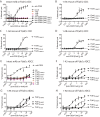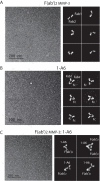Molecular characterization of human anti-hinge antibodies derived from single-cell cloning of normal human B cells
- PMID: 29191832
- PMCID: PMC5777262
- DOI: 10.1074/jbc.RA117.000165
Molecular characterization of human anti-hinge antibodies derived from single-cell cloning of normal human B cells
Abstract
Anti-hinge antibodies (AHAs) are an autoantibody subclass that, following proteolytic cleavage, recognize cryptic epitopes exposed in the hinge regions of immunoglobulins (Igs) and do not bind to the intact Ig counterpart. AHAs have been postulated to exacerbate chronic inflammatory disorders such as inflammatory bowel disease and rheumatoid arthritis. On the other hand, AHAs may protect against invasive microbial pathogens and cancer. However, despite more than 50 years of study, the origin and specific B cell compartments that express AHAs remain elusive. Recent research on serum AHAs suggests that they arise during an active immune response, in contrast to previous proposals that they derive from the preexisting immune repertoire in the absence of antigenic stimuli. We report here the isolation and characterization of AHAs from memory B cells, although anti-hinge-reactive B cells were also detected in the naive B cell compartment. IgG AHAs cloned from a single human donor exhibited restricted specificity for protease-cleaved F(ab')2 fragments and did not bind the intact IgG counterpart. The cloned IgG-specific AHA-variable regions were mutated from germ line-derived sequences and displayed a high sequence variability, confirming that these AHAs underwent class-switch recombination and somatic hypermutation. Consistent with previous studies of serum AHAs, several of these clones recognized a linear, peptide-like epitope, but one clone was unique in recognizing a conformational epitope. All cloned AHAs could restore immune effector functions to proteolytically generated F(ab')2 fragments. Our results confirm that a diverse set of epitope-specific AHAs can be isolated from a single human donor.
Keywords: antibody engineering; autoimmunity; immunogenicity; immunoglobulin G (IgG); monoclonal antibody.
© 2018 by The American Society for Biochemistry and Molecular Biology, Inc.
Conflict of interest statement
All authors are present or former paid employees of Genentech
Figures









References
-
- Klein U., Rajewsky K., and Küppers R. (1998) Human immunoglobulin (Ig)M+IgD+ peripheral blood B cells expressing the CD27 cell surface antigen carry somatically mutated variable region genes: CD27 as a general marker for somatically mutated (memory) B cells. J. Exp. Med. 188, 1679–1689 10.1084/jem.188.9.1679 - DOI - PMC - PubMed
Publication types
MeSH terms
Substances
LinkOut - more resources
Full Text Sources
Other Literature Sources

